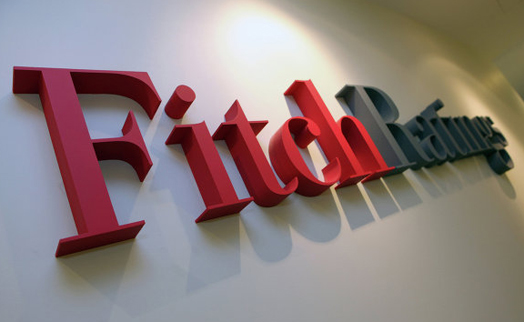YEREVAN, October 6. /ARKA/. Fitch Ratings has downgraded Armenia’s Long-Term Foreign-Currency Issuer Default Rating (IDR) to ‘B+’ from ‘BB-‘. The Outlook is Stable. The downgrade of Armenia’s IDRs reflects the following key rating drivers and their relative weights: the sharper than expected economic contraction in 1H20 and a sizeable downward revision to our GDP growth forecasts have put general government debt on a markedly higher trajectory than at our previous review in April. We now expect government debt to peak at a much higher level and no longer have confidence that it will be placed on a clear downward path over the medium term. Despite a relatively robust macroeconomic framework, there are also material and growing downside risks to our revised forecasts, for example should a resurgence of COVID-19 cases result in renewed containment measures, or there is a more prolonged escalation in the Nagorno-Karabakh conflict that negatively impacts the economy.
The recent large-scale military actions along the Line of Contact in the Nagorno-Karabakh conflict zone have extended over a broader area and been of a somewhat greater intensity than the last major confrontation in 2016. Stronger support for Azerbaijan from Turkey adds to uncertainty and increases the downside risk that the conflict is of a more protracted nature this time. The consensus view is that the conflict will remain outside the main economic areas thereby limiting the economic impact, given the potential for incursion of Azerbaijan offensives into Armenian territory to trigger Russian military involvement under the Collective Security Treaty Organization, and that mediation efforts will bring about a ceasefire and a return to a negotiation process in the short term. However, the extent to which concessions are viewed as politically acceptable is uncertain, with a significant risk of a resumption of hostilities over time, representing a material downside risk to our economic and fiscal projections, particularly in the event of any conflict within the territory of Armenia.
Armenia’s ‘B+’ IDRs also reflect the following key rating drivers:
Armenia’s institutions have facilitated an orderly political transition, and GDP per capita, governance and ease of doing business indicators are above the peer group medians. There is a robust macroeconomic policy framework, and credible commitment to reform and medium-term fiscal targets, underpinned by the IMF Stand-By Arrangement (SBA). Set against these factors are Armenia’s weaker external finances, a high, albeit declining, reliance on the Russian economy (for remittances, trade and FDI), borders are closed with two neighbors, and the long-standing conflict with Azerbaijan over Nagorno-Karabakh has the potential to further escalate.
Armenia’s external vulnerabilities, including high and growing net external debt, a relatively large structural current account deficit, a reliance on remittances and relatively weak FDI inflows, remain in place. However, the balance of payments has been relatively stable since the initial phase of the coronavirus shock. Having depreciated 5% against the US dollar in March, the dram has returned to close to the pre-pandemic level since end-April. The Central Bank has not intervened since USD94 million of net FX sales in March and April to support the normal functioning of the FX market, and net interventions for the year as a whole are lower, at USD36 million. In 2Q20 there was a moderate narrowing of the current account deficit, and net remittances, which were 9.0% of GDP in 2019, fell 22% in 1H20 yoy.
Fitch forecasts the current account deficit to narrow by 1.4pp in 2020 to 5.8% of GDP as sharp import compression more than offsets the fall in export demand, including from the collapse in tourism and weaker remittances. A statistical change to how the current account is calculated also lowered the end-2019 deficit by 2.2pp to 7.2% of GDP, mainly due to revisions to autos and tourism figures. We project that the recovery in domestic demand will drive a moderate widening of the current account deficit to average 6.4% in 2021-2022, which compares unfavorably with the ‘B’ median of 4.1%. Less than one-third of the deficit is covered by non-debt creating capital inflows, and net external debt is forecast to increase to 57.6% of GDP at end-2022 from 47.3% at end-2019, well above the peer group median of 29.9% of GDP.
The availability of IFI financing, and an increase in foreign exchange buffers coming into the crisis mitigate near-term balance of payments risks. FX reserves were USD2.7 billion in August, similar to the end-2019 level of USD2.8 billion having fallen to USD2.5 billion in April. Fitch forecasts that FX reserves will remain stable through 2022 at near 4.0 months of current external payments, higher than the end-2018 level of 3.5 months and in line with the ‘B’ median. In addition to the IMF budget support and EU grant funding the Armenian authorities have drawn on this year, there is USD1.3 billion of undisbursed IFI project financing in place. The government has already met the majority of 2020 financing needs, with domestic issuance of bonds amounting to close to 50% of the full-year total, and more than four-fifths of external financing from IMF budget support.
Fitch anticipates broad continuity in macroeconomic policy, including steady reforms to reduce corruption and strengthen institutions and public financial management. We do not expect significant problems in completion of the next IMF SBA review, which is likely to focus on the budget plans and the fiscal trajectory beyond this year as well as improving fiscal risk management, including from PPPs and this year’s off-budget on-lending measures, alongside ongoing measures to enhance tax reporting and efficiency.
Banking sector fundamentals are likely to weaken as a result of the pandemic-related shock, reflected in Fitch’s negative banking sector outlook for 2020. The non-performing loan (NPL) ratio increased to 6.6% in August from 5.5% in March, and we expect a sharper rise in 2021, although regulatory forbearance and the government support package should help banks manage NPLs and capital metrics. The Tier 1 capital ratio has been stable at 14.8% in August although it is unevenly distributed within the sector. The return on equity was 9.2% in August and profitability is expected to come under pressure due to weaker economic growth and higher risk costs. Central bank interventions supported bank liquidity in March and April and sector liquidity has been stable since then. Deposits grew by 12.5% yoy in August, although down from 18.4% in March, and we have not observed large deposit outflows since the resurgence of the conflict with Azerbaijan last weekend. Government subsidies and co-financing under the coronavirus response package have contributed to strong credit growth, of 17.8% yoy in August.
ESG – Governance: Armenia has an ESG Relevance Score of ‘5’ for both Political Stability and Rights and for the Rule of Law, Institutional and Regulatory Quality and Control of Corruption, as is the case for all sovereigns. These scores reflect the high weight that the World Bank Governance Indicators (WBGI) have in our proprietary Sovereign Rating Model. Armenia has a medium WBGI ranking at the 48th percentile (an improvement from 46th in 2018 due to control of corruption and voice and accountability), reflecting a recent track record of peaceful political transitions, a moderate level of rights for participation in the political process, moderate institutional capacity, established rule of law and a moderate level of corruption.
The main factors that could, individually or collectively, lead to positive rating action/upgrade are:
– Public Finances: General government debt/GDP returning to a firm downward path over the medium term, for example due to a post-coronavirus-shock fiscal consolidation.
– External Finances: A sustained improvement in external indicators, for example lower net external debt, a narrower current account deficit or improved FDI inflows.
– Structural: Further improvement of structural indicators such as governance standards, leading to convergence towards the ‘BB’ peer median, and reduction in the downside risk of a prolonged escalation in the conflict with Azerbaijan over Nagorno-Karabakh.
The main factors that could, individually or collectively, lead to negative rating action/downgrade:
– External Finances: A worsening of external imbalances, potentially evidenced by higher net external debt or current account deficits, or the recurrence of external financing pressures leading to a fall in reserves and a rise in the interest burden.
– Public Finances: A sustained upward trajectory in general government debt/GDP over the medium term, for example due to a structural fiscal loosening and/or further weakening in GDP growth prospects.
– Structural: A prolonged escalation in the conflict with Azerbaijan over Nagorno-Karabakh to a level that would affect economic and financial stability, as well as macroeconomic and fiscal indicators. -0-








